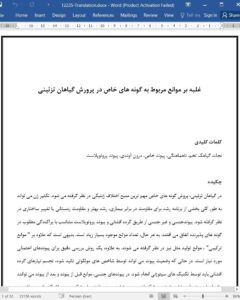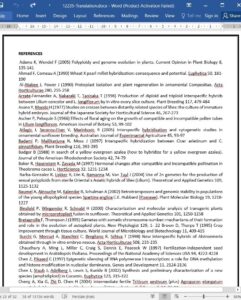ABSTRACT
In ornamentals, interspecific breeding is considered to be the most important source of genetic variation. The introgression of genes may be part of a breeding program towards disease resistance, better growth vigor, winter hardiness or morphological alteration in general. Both sexual and asexual hybridization, by pollination and protoplast fusion respectively, are fit to induce the desired introgression into the acceptor species. However, the number of possible barriers is very high. Obviously, apart from the actual “fusion barriers” also regeneration barriers are met; moreover, a thorough screening procedure of possible hybrids is needed. Whereas the hybrid status can be confirmed by molecular markers, visualization of introgression needs to be performed by cytogenetic techniques. In sexual crosses, both prezygotic and postzygotic barriers can inhibit the creation of a fertile interspecific hybrid; in asexual crosses regeneration of hybrid cells is often a bottleneck. For this reason in vitro techniques are indispensable for interspecific breeding in a large number of crops. Polyploidization protocols, whether driven by unreduced gametes or by mitosis arresting chemicals, can ease the fertilization or restore fertility of F1-hybrids. In the latter case, unreduced gametes arisen after FDR (first division restitution), SDR (second division restitution) and IMR (indeterminate meiotic restitution) still offer the possibility of direct gene introgression in the next generation, even if the hybrid produces no normal (haploid) gametes.
1. INTRODUCTION
Breeders of ornamentals are in a constant search for new technologies that may offer a valuable aid in cost reduction, product quality enhancement and assortment enlargement. Plant tissue culture comprises a set of in vitro techniques, methods and strategies. It has been exploited to create genetic variability to improve crop plants and their health status and to preserve germplasms (Taji et al. 2002). In vitro techniques for the culture of protoplasts, anthers, microspores, ovules and embryos have been used to create new genetic variation in breeding lines (Brown and Thorpe 1995). Apart from micropropagation, the most important in vitro applications are induction of somaclonal and gametoclonal variation, pathogen eradication, germplasm conservation, synthetic seed production through somatic embryogenesis, haploid breeding, polyploid breeding and interspecific hybridization. Interspecific hybridization is a means of transferring genes within related species; as such, it offers an alternative for genetic modification. Van Tuyl and De Jeu (1997) considered interspecific hybridization to be the most important source of genetic variation in ornamentals. The introgression of genes may be part of a breeding program towards disease resistance or morphology alteration (Uhlinger 1982).











